2.11 Making Fortified Wine
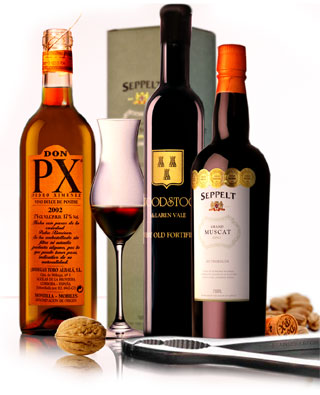
All fortified wines are wines to which spirit has been added, raising the alcohol level of the finished wine to around 17 - 22% Alc/Vol. The spirit strength ranges from approximately 80% - 95% Alc./Vol. Hence, such wines are referred to as 'fortified', the word originating from the Latin 'fortis', meaning 'strong'. Apart from being a high strength alcohol solution which simply raises the alcohol level, each spirit has its own distinctive character that contributes to the finished wine. Brandy spirit, for example, can often add significant nutty tones.*
Some fortified winemakers, like James Godfrey from Seppelt, believe that spirit selection is probably the single most important factor in fortified production and that"...it will dictate the ultimate quality and style of the wine...You choose soft, clean and neutral spirit for Muscat, Sherry and Tokay. For Tawny Ports you can use low strength spirits with grape flavour and this can really shape their house style." Godfrey sums up the challenge of Fortified winemaking stating that: "...balance is the key for great fortified wines...Maturation is a process of concentration and all things concentrate over time so a young balanced wine will always stay in balance, but maturation won't cure the problem of balance if it's not there from the start."(1)
In this chapter, we examine two of the world's greatest expressions of Fortified wine - Sherry and Port - beginning with Sherry, as it is arguably the archetypical fortified and also the most complicated to make. An understanding of its production illuminates the manner in which all other fortified styles are produced.
Making Sherry
Jerez, the traditional home of Sherry in Southern Spain, has exported Sherry wines since at least Roman times and today its wines account for the greatest volume of any Spanish 'Denomination of Origin' exports. They are sold in over fifty countries. The enormous international success of these wines is, to a large degree, due to the long export tradition, the broad consumer range and the wine's exceptional quality, which has its source in the regions unique winemaking and ageing processes. As well as being an incredibly versatile drink, Sherry generally delivers remarkable value for money, with some examples sitting comfortably alongside the great wines of the world.
In early Australia, the production of Sherry reflected European tastes of the time and the popularity of the drink itself played a role in the emerging wine industry. Today, Sherry has become somewhat unfashionable, often perceived as the drink of social matrons and the elderly. The matter was compounded for some time by marketers who insisted on overdosing young, light sherries with sweetening wine in the belief that it made them"easy to drink". This might have lifted sales in the short term, but as one commentator observed, "A fino takes sweetening about as well as a brick floats on a pond." Attitudes towards Sherry are slowly changing as wine-lovers are discovering the wonderfully different taste experiences Sherry offers, and the past few years have witnessed a widening range of imported Sherry wines on the Australian market.
In its creation and maturation Sherry is a perverse wine that presents challenges to the winemaker equal to those found in the making of fine Champagne. The chief difficulty is that once the grapes are crushed it is impossible to know for sure what style the wine will develop into. It can be influenced by winemaking flair to a degree, but Sherry ultimately charts its own course. This is partly due to the unique manner in which it is matured. Unlike table wine, where the casks are completely filled to prevent oxidisation, Sherry casks are about three quarters filled leaving the wine's surface exposed to oxygen. However this surface, as we shall see, is protected by a natural growth of yeast cells and it is this 'magical' element of Sherry production which results in its variety and much of its remarkable aroma and taste.
There are three general sherry styles produced in Australia, inspired by the traditional Spanish styles: Fino, Amontillado and Oloroso. (We shall examine in detail the various styles of Sherry further on). The first two styles are made using the special 'flor' yeast. All three styles are produced via a system of fractional blending and ageing known as the solera system. The principles for their production remain based upon traditional Spanish techniques, although some innovations have inevitably being introduced, for Australian wine makers have never been too hampered by tradition.
Grape Varieties used in Sherry Production
There are three grape varieties used - Palomino, Pedro Ximenez & Muscat (Spanish: Moscatel).
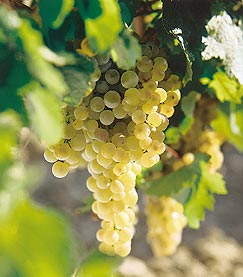 |
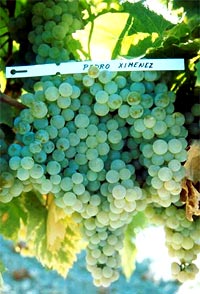 |
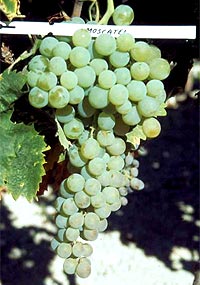 |
| Palomino | Pedro Ximenez | Moscatel |
The Palomino grape is widely adaptable to a variety of soils and climates. It is a very vigorous vine, yielding up to eight tonnes per acre (20 tonnes per hectare). The clusters are large, stiffly loose to well-filled. The berries are greenish yellow, with a greenish white bloom, and tough skinned. Due to its particular viticultural and oenological properties, its use has increased steadily and it remains the predominant variety in Sherry production.
Pedro Ximenez or "PX" as it is often called, has taken a bit of a back seat to Palomino, largely because Palomino is more productive and less disease prone. (Pedro's thin skin makes it susceptible to disease). The vine is of upright and vigorous growth. The leaves are small to medium in size, bright green, with a smooth, flat upper surface, and a lower surface with hairs on the clearly defined veins. They are 5-lobed and slightly irregular in shape. The bunches are below average to average in size, cylindrical, winged and compact. Although the berries may vary in size they ripen at the same time. The berries are almost globular, thin-skinned, transparent and soft. Pedro Ximenez produces sweet, high quality wines possessing an intense dried fruit, mollases flavour and a distinctive bouquet which is achieved by leaving the harvested grapes in the sun so they lose some of their moisture. Their thin skin speeds this process. Spain's Emilio Lustau is arguably the greatest exponent of this style, with the famous American wine critic, Robert Parker describing their wines as"...simply staggering in quality...Sherries such as these remain among the last great unknown wine bargains of the world. They must be tasted to be believed".
Australian viticultural pioneer, James Busby brought Pedro Ximenez specimens back from Xeres de la Frontera in his 1832 collection, but Macarthur makes no mention of it in his notes on his experiments with vines surviving from that collection which showed good adaption to Australian conditions.
South Africa had a large number of Muscat vines under cultivation in the 19th century. Egyptian traders had given them Muscat of Alexandria and their European immigrants had brought cuttings of Muscat a Petits Grains with them. Cuttings of both types of Muscat, amongst other derivatives, made their way to Australia. John Francis Brown, grandfather of the Brown Brothers who today run the Milawa vineyard in north-east Victoria, was an early exponent of Muscat. Brown planted his muscat vines at the base of the Australian Alps in the late 19th century where the warm, dry summers and cool, wet winters of the north-east of Victoria closely resembled its original Mediterranean conditions.The vines thrived and it was quickly realised that even in fairly crude and simple conditions that prevailed in early wineries, the variety could be relied upon to produce good wines, year in, year out. Almost 100 years after the first Muscat grapes were planted at Milawa, several different types of Muscat have been cultivated and several different wine styles are produced. From delicate, perfumed, crisp, dry whites, to rich late harvest table wines and the unique and renowned fortified styles that Australia has become famous for. In Spain's Jerez region it gives high-quality, sweet, rather perfumed wines that carry its name. However, it now occupies only a very small proportion of the plantings.
Harvesting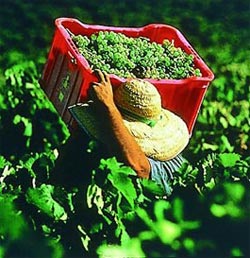
The base wine for sherry is produced in the same way as making dry white table wine. Grapes are harvested at around 10-11° baume (similar to the baume for sparkling wine). Natural acid levels are quite high at this level, and a pH in the range of 3.0 - 3.4 is expected. The "cutting" of the bunches is usually carried out manually so that the grapes arrive at the wine press in optimal conditions. To this end, plastic boxes with a capacity no greater than 18kg. (40 lb) are usually used. Grapes to produce dry styles are quickly transported to the winery. On the other hand, those to be made into sweet wines, especially Pedro Ximénez and Muscat grapes, are set out in the open air on mats to raise their sugar content while lowering their moisture content via evaporation. Throughout this process, the grapes are covered at night to protect them against the dew. The length of time of this operation continues depends upon climatic conditions and may last more than one week.
The Pressing
Once in the winery, the grapes are unloaded onto conveyor belts where stems, leaves, and unsuitable bunches are discarded in order to reduce tannin. The remaining grapes pass into machines that crush them gently to open up the berries skins. The grapes then pass directly to the presses where, through the light application of pressure, the first must ( a mixture of juice, pulp, skins and seeds) is obtained. This process yields approximately 70 Iitres of must per 100 kg of grapes. In Spain, only the must from this first pressing will be used. (Usually further, more energetic, pressings follow in order to extract the remaining juice from the grapes. The juice from these medium and higher-pressure extractions can never be used in the production of Sherry although it can be used, under the watchful eye of the Spanish Regulatory Council, to produce other wines, as well as for distillation or for obtaining other sub-products).
The Palomino Grape produces must that is low in acidity, typically at a pH range of 3.5-3.7, but it can be as high as 4.0. Correction of acidity is commonly used to bring the pH to ~3.2 (or 4.5 g/l) before fermentation. Traditionally this was done by addition of plaster or gypsum (essentially calcium sulfate), which reacts with potassium hydrogen tartrate in the must to generate (soluble) potassium sulfate, precipitating calcium tartrate and releasing tartaric acid. Tartaric acid is usually used directly when acidification is needed. In the past, the main need to increase acidity was due to the picking of very ripe grapes, but with better means now available to assess ripeness, it is possible to pick grapes before they begin to lose acidity.
Fermentation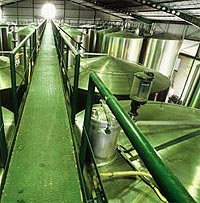
The first must obtained from the pressing goes directly into vertical stainless steel tanks to be fermented in a temperature-controlled process which takes place between 22°C and 24ºC. Some old Spanish producers still practice the old system of fermenting in new oak barrels or "botas", with the dual purpose of preparing the casks for later use in the long ageing process, and at the same time achieving a characteristic vinification of the must. However, temperature-controlled fermentation makes it possible to select a lower temperature in order to direct the path toward Fino production, or a slightly (3°) higher temperature to favour Oloroso production. The temperatures in either case are higher than would be usual for a white table wine. The basic idea here is not to produce a fruit-driven wine, but to make a base wine with good extract and low acidity that can mature in the solera system.
Fermentation used to be performed by natural yeasts, but growers are now adding cultivated yeasts. (There is an increasing tendency to include flor yeasts in the yeast preparation used to seed fermentation. This improves the chances for getting development of a good flor cover immediately after fermentation).
The fermentation process in the Jerez Region is divided into two clearly differentiated stages. In the first days the so-called "stormy" or "tumultuous" fermentation process takes place during which more than 90 per cent of the total sugar contained in the grape is converted into ethyl alcohol and carbon dioxide. Following this first phase, there is a second, slow stage, after which a delicate, totally dry white wine with an alcohol content of between 11 and 12% vol. is obtained. The characteristics of this wine will determine its classification before entering the ageing process.
The 'Mystery' of the Flor
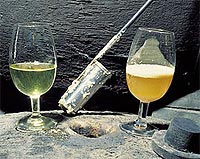
Winemakers now sample all of the individual vats or 'butts' (barrels) and take the first of many important decisions which will determine the type of ageing which the year's different wines will undergo. Some of the palest, lightest wines that are clean to the nose with outstanding aroma will be set aside for ageing under a veil of "flor", in order to produce dry Sherry styles (Fino and Manzanilla). Other wines, also clean on the nose and palate, but with more body will be classified as Oloroso's. The wines classified as Finos or Manzanillas will be fortified with wine-distillate (pure alcohol (96%), added d of hours so as not to have an abrupt effect) to bring their alcohol content up to 15% vol. while those destined to become Olorosos will be fortifbsp; or sli, according to each producers individual style.
The different levels of fortification and alcohol content determine the type of development undergone by the wines in the next phase of their maturation. With their new alcohol content, the wines are transferred to typical oak barrels. Different to other wine regions were the wines age in hermetically sealed vessels in order to prevent their oxidation, the ageing process for Sherry and Manzanilla takes place in 600 litre American oak butts which are filled to 5/6 of their capacity, leaving a volume of air inside the butt "two fists high".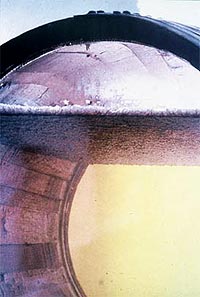 The next development of Sherry is determined by whether 'flor' (meaning flower) forms on the surface of the wine. In the past the growth of this flor veil was one of the great mysteries of sherry, well promoted by their P.R. department, and even up to this day, some producers continue to perpetuate old myths. The flor is actually formed by live yeasts belonging to the genusSaccharomyces ellipsoideus, (in particularS. beticus, S. cheresiensis and S. rouxii) In the past, naturally occurring micro-flora yeast sometimes produced unpredictable results. Today, selected pure flor yeast cultures are used. The Beticus is usually the strongest (it is encouraged by heat and predominates, especially in Jerez). These yeasts have the unusual property of living in alcohol levels above 15%. The flor forms as soon as fermentation is completed and the wine is racked off the lees. The flor grows on alcohol, glycerol, and other nutrients provided by the wine. The process is proaerobic; because it requires oxygen, the flor yeasts live at the surface where they form a protective cap that prevents oxidation of the wine. The thicker the layer of Flor, [as pictured right in a special cut-away barrel] the drier and finer the style of Sherry. In the case of Finos and Manzanillas - at 15ºC - the veil of "flor" remains constant over all of the wine's free surface inside the butt.
The next development of Sherry is determined by whether 'flor' (meaning flower) forms on the surface of the wine. In the past the growth of this flor veil was one of the great mysteries of sherry, well promoted by their P.R. department, and even up to this day, some producers continue to perpetuate old myths. The flor is actually formed by live yeasts belonging to the genusSaccharomyces ellipsoideus, (in particularS. beticus, S. cheresiensis and S. rouxii) In the past, naturally occurring micro-flora yeast sometimes produced unpredictable results. Today, selected pure flor yeast cultures are used. The Beticus is usually the strongest (it is encouraged by heat and predominates, especially in Jerez). These yeasts have the unusual property of living in alcohol levels above 15%. The flor forms as soon as fermentation is completed and the wine is racked off the lees. The flor grows on alcohol, glycerol, and other nutrients provided by the wine. The process is proaerobic; because it requires oxygen, the flor yeasts live at the surface where they form a protective cap that prevents oxidation of the wine. The thicker the layer of Flor, [as pictured right in a special cut-away barrel] the drier and finer the style of Sherry. In the case of Finos and Manzanillas - at 15ºC - the veil of "flor" remains constant over all of the wine's free surface inside the butt.
During this time, the yeasts are interacting constantly with the wine, consuming its alcohol and other nutrients and endowing it with its characteristic nutty aromas and flavours. This type of ageing process is known as "crianza biologica"or biological ageing.
Yeast in the flor layer are continually dying and being replaced by new growth. (The dead cells fall to the bottom of the cask and the butts in a Fino Solera have to be cleaned out every 25 years or so because of this accumulation.) Sometimes, in the case of Fino or Manzanilla wines which are aged biologically, the veil of "flor" can reduce or even disappear entirely. This might be due to natural causes or due to a decision taken by the cellar master who fortifies the wines above the yeasts' maximum limit (over-fortifying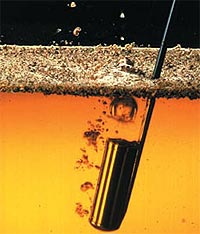 prevents the growth of flor yeasts). If flor dies off in casks of a Fino that are more than 3 years old, this gives rise to the class of Sherry Wines known as Amontillado, a jewel among the world's wines. If the flor dies sooner, the wine can only be used for a blended style (such as Medium) and cannot be used for Fino or Amontillado. In the case of Olorosos, fortified to over 17% Alc./Vol., this higher strength impedes the development of the "flor" and this growth disappears. The wine is therefore in permanent and direct contact with the oxygen in the air. This ageing is known as oxidative or physical-chemical ageing.
prevents the growth of flor yeasts). If flor dies off in casks of a Fino that are more than 3 years old, this gives rise to the class of Sherry Wines known as Amontillado, a jewel among the world's wines. If the flor dies sooner, the wine can only be used for a blended style (such as Medium) and cannot be used for Fino or Amontillado. In the case of Olorosos, fortified to over 17% Alc./Vol., this higher strength impedes the development of the "flor" and this growth disappears. The wine is therefore in permanent and direct contact with the oxygen in the air. This ageing is known as oxidative or physical-chemical ageing.
Being constantly innovative, the Australian wine industry has come up with a faster, more efficient system of flor sherry production. Shallow tanks of around 2 metres depth have been developed, and the flor yeast is grown over the top. Often it is sprayed on the surface with an atomiser, or layered from an established film. Another Australian invention for speeding up the sherry process was developed by J.C.M. Fornachon. It consists of a stainless steel column, packed with oak chips upon which flor yeast grows. Once the process is in place, one pass down the column is sufficient to ensure that enough acetaldehyde (flor yeast character) has passed through to the base wine. After this pass, the wine undergoes some barrel maturation and fortification.
The Ageing of Sherry: the "Solera System"
In the ageing cellars, the wines repose organised according to their different degrees of ageing. The butts are lined up in rows and stacked up to three or four different levels, each of which corresponds to a scale. The lowest row or scale is known as "solera"(from the Spanish word suelo, or ground)** and contains the oldest wine. The butts in the row immediately above it, the primera criadera, or first nursery, contain wine somewhat younger than the row beneath and in the row above that, the second nursery, the wines are younger still. And so on until we reach the last and highest row.
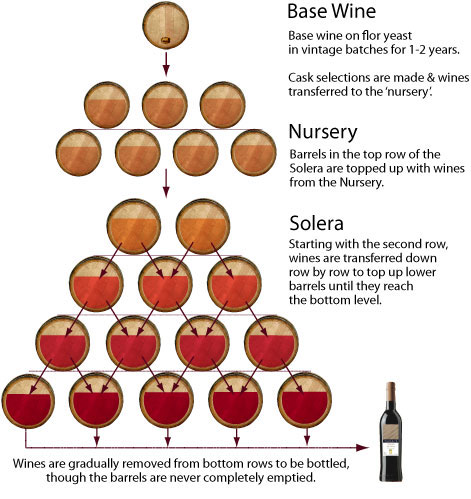 |
| Above: Diagram of a typical Solera System. |
Wine for bottling is always drawn off from the ground-level butts. Only a small amount of wine is taken from each butt during this procedure. Later, the wine extracted from the butts on the ground-level row is replaced by the same quantity of wine from the first nursery. This wine in turn is replaced with wine from the second nursery and so on up to the wines on the highest row of butts, which are finally blended with the new wines from the last harvest. This operation is known in Jerez as "running the scales" and is usually carried out with implements called the"canoe"and the"sprinkler" so that the new wine drips into the butt little by little, as if it were dew, and so that the "flor" protecting the wine will not be damaged. In a solera, where the wine is continuously refreshed, the flor growth continues almost indefinitely. The longer the wine spends on flor, the greater the development of nutty and almond characters.
The ageing system of Sherry Wines is therefore a dynamic process and involves a methodical blending of the young wines with other, more mature wines in order for them to acquire gradually the fine qualities of old wines which have enjoyed many years of ageing.
Although in exceptional cases some Sherry houses age their wines statically by a system of vintages, the solera method is indisputably the genuine ageing process for Sherry. The blending of wines originating from many different vintages means that it is impossible to refer to a specific year's harvest - sherry with a vintage added to the label must be a misnomer. But a sherry labeled Solera (say) 1990 purports to show that it comes from a group of butts laid down that year, and theoretically, there always remains an infinitesimal fraction of the original wine. It is possible to establish an average age for the solera or ground-level wine based on a series of factors such as the number of scales, the percentage of wine transferred every time the scales are run, or the frequency of the operation itself.
The minimum ageing for Spanish Sherry Wine is three years although it is frequently much longer. Certain styles only acquire their most desirable characteristics after decades of ageing. For this reason, the Denomination of Origin Regulatory Council allows certain Sherry Wines which are particularly old to include on their labels their average age. However, to obtain this privilege the bodega involved has to undergo a series of highly specific tests. In Australia, wines usually spend from one to two years on flor, but special wines are kept in contact with the flor for up to seven years or more before being blended and bottled.
 |
| Topping up the Solera is usually carried out with implements called the "canoe" and "sprinkler" so that the new wine drips into the butt little by little so that the "flor" protecting the wine will not be damaged. |
When Sherry is finally bottled, the wine is clarified and filtered, put through cold stabilization and bottled under inert gas. Sulphur dioxide is not used, except at the start of fermentation.
**- no one quite knows how the word Solera came to stand for this complicated Jerez system of equalising wines. One of the meanings of the word is a "plinth" and this might give some clue to the provenance of the word, for it has been argued that when the bodegas were formerly used as drinking rendezvous for the friends of the proprietor, guests used to ask for their next glass off the floor, i.e. from the lower butts on the scantling which were the best.
Styles of Sherry Wine
A fine Sherry has all the attributes of a great wine. Often the aromas are so exquisite, that there is more pleasure in smelling than in drinking these wines, though the flavours of good Sherry are invariably fascinating and complex. The range of grape varieties, the biological, oxidative or mixed nature of the ageing process coupled with skilled blending results in a rich palate of different styles as follows:
Dry "Generoso" Wines. These are quality wines made during total or partial ageing under the veil of flor - the biological process undergone through the spontaneous appearance of a veil of yeasts on the surface of the wine typical to the Jerez area, which contributes a series of specific analytical and organoleptic properties to the wines. The alcohol content of these wines is no lower than 15º.
Manzanilla - Sanlucar de Barrameda. The special microclimatic conditions in the bodegas located in the coastal town of Sanlucar de Barrameda in Spain produce a very distinctive kind of "flor". This very special kind of biological ageing confers unique characteristics to the wines. Indeed they are so special and are produced in such a well-defined area that they have their own Denomination of Origin, that of "Manzanilla - Sanlucar de Barrameda".Manzanilla'a are straw-coloured wines with a dry, sharp bouquet which is light and often salty on the palate. It is exclusively aged under "flor" in Sanlucar de Barrameda. Its alcohol content varies from 15º to 19º. Although the definitive Manzanilla is the so-called Manzanilla-Fina, an extremely pale, light , dry wine, depending on the length and circumstances surrounding its ageing process, there are other types of Manzanilla. Among these, special mention must be made of Manzanilla pasada which is less pale and has more body due to a slight oxidation of the wine during its very long ageing process.
Fino. Straw-coloured or golden, finos have a spicy, delicate aroma reminiscent of almonds, and are dry and light in the mouth. Their special properties are the result of the exclusive ageing process under the veil of flor. The very dry finish of Fino is due to the consumption of glycerol by the flor. They have an acquired alcohol content of 15º -18o. Fino are best served cold.
Amontillado. The ageing process used in these wines includes an initial phase under the veil of flor - similar in procedure and duration to that undergone by finos - followed by a phase of oxidative ageing. The result is an amber-coloured wine with aromas of hazelnut, mildly tangy, soft and full in the mouth, with an alcohol content of between 16º and 22º.
Oloroso. An initially dry wine, from amber to mahogany in colour, with a strong aroma reminiscent of walnuts, full-bodied, with an alcohol content of between 17º and 22º. Ageing begins under the veil of flor, then continues with a phase of oxidative ageing. Ideal as an aperitif, as well as with game and red meats.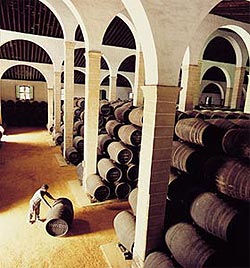 Palo Cortado. A bright mahogany-coloured wine, with a bouquet suggestive of hazelnuts and a dry palate. Palo Cortado is a special style that results from an early transition from development under flor to oxidative development. This used to occur when the flor failed to develop at an early stage; now it is more a matter of selection on the basis of the organoleptic qualities of the wine. After a few months development under flor, it is fortified to 18-20% cent alcohol, and develops into a halfway house between Amontillado and Oloroso. The decision is made at the second classification. A Palo Cortado is recognized by an aroma similar to Amontillado, but the body associated with Oloroso. One theory is that these wines occur when an unusually high content of malic acid leads to a malolactic fermentation; this could explain the lactic quality that is associated with the style. Its alcohol content varies between 17º and 22º.
Palo Cortado. A bright mahogany-coloured wine, with a bouquet suggestive of hazelnuts and a dry palate. Palo Cortado is a special style that results from an early transition from development under flor to oxidative development. This used to occur when the flor failed to develop at an early stage; now it is more a matter of selection on the basis of the organoleptic qualities of the wine. After a few months development under flor, it is fortified to 18-20% cent alcohol, and develops into a halfway house between Amontillado and Oloroso. The decision is made at the second classification. A Palo Cortado is recognized by an aroma similar to Amontillado, but the body associated with Oloroso. One theory is that these wines occur when an unusually high content of malic acid leads to a malolactic fermentation; this could explain the lactic quality that is associated with the style. Its alcohol content varies between 17º and 22º.
Sweet Natural Wines. Pedro Ximenez and Moscatel are other wines that are produced in Jerez by a Solera system similar to Sherry, each using grapes exclusively from the varietal. They are produced from very ripe grapes, with high sugar content of up to 400 g/l, which is increased further by desiccation through drying in the sun (typically on sand for 7-10 days). Some oxidation is associated with the process and is seen in the style of the wine. There is some variation in style, because the wines can be fermented to completion (with the sweetness resulting from the sugar that remains) or can have alcohol added before or during fermentation in a mutage-like process to increase the level of residual sugar. Traditionally, after pressing, the must was put into 500 litre casks which already contain 60 litres of wine spirits. (Before 1987, some PX wines would have low alcohol levels, around 9%, but now because of the need to conform with E.U. regulations, the style is required to have >15% alcohol). The wines thus obtained are very dark in colour, sweet and immensely concentrated in reducing materials.
Pedro Ximenez. This style of Sherry is one of the great sweet wines of the world. A dark, mahogany-coloured wine with a deep bouquet of raisins and mollasses, it is a smooth, highly viscous and sweet style. Pedro Ximenez Sherry is a perfect match with chocolate, and is also consumed over ice in the warmer weather.
Moscatel. A dark mahogany-coloured wine, produced exclusively from sun-dried grapes of the same name (English: Muscat). It is a smooth, sweet wine with an aroma characteristic of this grape variety.
Blended styles of Sherry
Originally dry (Generoso) wines are occasionally blended with sweet wines to produce other, slightly sweet Sherry wines, such as:
Pale Cream: A straw-coloured wine with a sharp, delicate bouquet. It has a delicate, slightly sweet flavour. Its alcohol content varies between 15.5% and 22º. Medium: An amber- to mahogany-coloured wine with a delicate bouquet and a slightly sweet palate. Its alcohol content varies between 15º and 22º. The richest, darkest versions of Medium are often called "Golden".
Cream: A sweet, mahogany-coloured wine, made from Oloroso. It has an intense aroma, velvety palate and full body. Its alcohol content varies between 15.5º and 22º.Note: Much of the information on Sherry here has been supplied courtesy of the official Spanish Sherry Organisation, Spain. 
Making Port
Port is the wine of Portugal, and derives its name from the country's second largest city, 'Oporto' located in the Douro region. Although the Portuguese had been making wine for hundreds of years since the Romans introduced wine to the Iberian Peninsula in the first century B.C., the first wine from Oporto was really just red table wine. The recorded history of Port begins in the 17th-century, however, no one knows exactly when port as we know it today was first created. One story is told of a wine merchant in Liverpool, who in 1678, sent his sons to Portugal to find a wine source. In the Douro Valley they came upon a monastery in Lamego. The abbot was adding brandy to the wine during rather than after fermentation thereby producing a port-type wine. In any event, sometime during the end of the 1600's or beginning of the 1700's, someone came up with the idea of stopping the fermentation with brandy while the wine was still sweet, fruity and strong.
It was the geopolitics of Europe in the middle of the 17th-century, that caused the British to conscientiously develop Portuguese wine into Port as we know it today. In 1678 Britain declared war on France and blockaded French ports. This created an instant shortage of wine. Britain has been the traditional trading partner and ally of Portugal since 1373 when an agreement was signed pledging "perpetual friendship." It was natural then, that the British wine merchants turned to Portugal to find an alternative to the French wines they preferred. Unfortunately, wines of the quality they were looking for were not readily available. Wine making in Portugal had not become the serious endeavor it was in France. So if the British wanted good wine, they were going to have to oversee its production themselves. And this they did. Traveling inland along the Douro River, they found darker and more astringent red wines in contrast to those they had seen near the coast. In order to stabilize them for shipment to England, merchants added"a bucket or two"of brandy to the barrels of wine before sending them off (...so the story goes). This early wine from Oporto was not highly praised back in London. Any popularity it enjoyed was due more to its availability than anything else. As a result, sales fluctuated with the warming and cooling of Britain's relations with France.(2)
Today, over 80 different grape varieties are permitted in the production of Portuguese port, and traditional vineyards have many of their vines intermingled together, often without knowing where and in what quantity. In recent years research has been conducted to make sense of this vinous 'tapestry' in order to establish which grape varieties in fact make the best contribution to port. The black grapes that have gained approval include: Tinta Barroca, Touriga Francesa, Tinta Roriz and Tinta Cao, and for white port the perfect varieties include Gouveio (Verdelho), Malvasia Fina and Viosinho.
In Australia, the chosen varieties for port production are quite different, although the wine-making process and end results are similar. Grenache, Shiraz, Mataro, Touriga and Cabernet Sauvignon are the common port varieties, with some Tokay grapes also being used. That is not to say that all wine makers are only using these - traditional varieties are also employed, particularly for the production of Vintage Port.
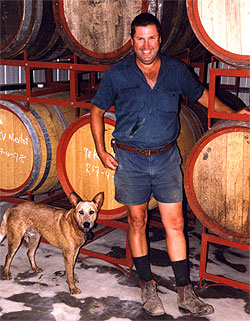 |
| Vintage Port winemaker, Andrew Sutherland Smith, at his Warrabilla winery at Rutherglen, Victoria. |
Making Vintage Port
Vintage Port is different from other port styles in that 95% must be the product of the one vintage, rather than being a blend. Consequently, Vintage Ports will only be produced in years when the required fruit ripeness is achieved. Australian Vintage port styles have tended to be sweeter than their Portuguese counterparts, possibly a legacy from the early days of the Australian colony when a love of sweet, strong drinks by the working class prevailed in the absence of spirits."The driest Portuguese Vintage Port I've heard about was 2.7º Baume, but most would be around the 3.5 to 4.0º Baume mark", says veteran Rutherglen winemaker Andrew Sutherland Smith of Warrabilla Wines. "At harvest, they would be much less ripe than their Aussie counterparts which at the same stage would have less fresh fruit and possibly a bit of raisin in there. Tannins soften, as fruit matures, so possibly the "grip" would be much more pronounced in young Portuguese wines".(3)
In Australia, Dry-land Shiraz grapes are perfect for vintage port with some of the best wines coming from Rutherglen in North East Victoria, although South Australia has consistently produced outstanding Vintage Port from McLaren Vale and the Clare Valley.
Despite this, like Sherry, Vintage Port has lost much of its popularity. In part this may be the fault of a misguided marketing campaign that has tried to convince Australian wine lovers to finish the bottle in one sitting, lest the port go off. All that this directive has produced are some excessive hangovers as a story told by Don McWilliam of McWilliam's Wines testifies: Don, on one of his regular wine tours, was in the Barossa Valley, where he met Peter Lehmann who invited him back that evening for a game of cards and a drop of vintage port. Peter invited another mate, then produced the Vintage Port - in fact 2 gallons of the stuff - opened the flagon and promptly tossed the cork in the fireplace. As the story is told, the port was indeed consumed in one sitting. Don McWilliam remained over .05 for three days and has never touched vintage port again(although he has been observed lacing his morning coffee with a dash of McWilliams XO Brandy!)
While some of the aromatics may dissipate, in reality, vintage port once opened will last for weeks. Alternatively:
(2) decant the bottle into some re-sealable half bottles to enjoy at your leisure.
There are other more tangible explanations for Vintage Ports demise.
Andrew Sutherland Smith suggests,"The trouble seems to be that to make a great Vintage Port you need grapes that could also make a sensational dry red. The fruit has to show massive colour and great tannin. There is way more money in dry red, so why bother with Vintage Port? The best reason why I make Vintage port isn't about money. It's about the joy of making something that is going to live for a very, very long time. Classic wines that represent the pinnacle of Aussie winemaking. Wines that people will be discussing long after the winemaker has gone the way of the dodo."(4)
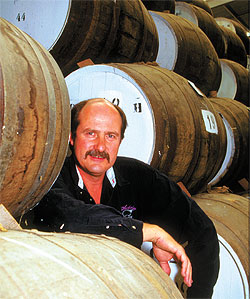 |
| Seppelt Fortified winemaker, James Godfrey produces sherries, ports, tokays and muscats renowned both in Australia and internationally. |
So how is Vintage Port made?
The procedure is quite similar to that of making red wine. (See Chapter 2.8) Typically, the grapes are picked very ripe with a potential natural alcohol of around 14% alc/vol, then de-stemmed and crushed. Open-topped fermenters are traditionally used, with fermentation on skins, and lots of pumping over or dunking using heading -down boards in order to extract maximum colour and tannin. When the natural sugar levels reach about 9° baume, the skins are removed and the fortifying spirit added, so that the finished product reaches an alcohol level of around 18% alc/vol. Some wine makers prefer to add brandy spirit to the fermenting port in order to maximize colour extraction. This also has the benefit of creating a more integrated wine, requiring less time to reach its peak. After fortification, the wine is clarified and transferred to oak for maturation."Maturation in small wood barrels is my personal preference" says Seppelt Fortified winemaker, James Godfrey, "as it maintains better freshness over time. Old oak is an essential part of the fortified recipe because the higher alcohol content of fortified wine can extract unattractive characters from newer oak".
Vintage Port does not need extended time aging in barrel (as little as 1-2 years is sufficient), as maturation is destined to occur in the bottle. This is yet another significant negative: the consumer must cellar the wine for decades before it is ready to drink, raising the risk of drinking it too soon, or opening it too late. It is not uncommon for Vintage Ports to peak after 20 - 30 years of cellaring and many great vintages will last much longer. Old vintages from Seppelt, Hardys and Penfolds in South Australia, or from Rutherglen in Victoria are worth seeking out and will reward the wine lover with unforgettable tasting experiences.
Despite its downsides, Vintage Port continues to excite a small band of enthusiasts, albeit mostly winemakers. Andrew Sutherland Smith explains his passion for this underdog of the fortified wine world:
'Off skins' has the advantage of using less spirit, and also adding it at exactly the right stage to get the final sugar level and alcohol absolutely right. 'On skins' allows the spirit to extract more colour and tannin out of the fruit. Ethanol is the solvent for red wine colour, too. Messy, expensive and inaccurate but it has awesome benefits, especially with one to two days soaking afterwards.
You can make Vintage Port from anything in Australia, but it doesn't mean it's going to be any good. Largely there are two major Vintage Port styles in Australia. The classic Shiraz based styles, often quite sweet, viscous, luscious, made from very ripe slightly raisined fruit. These can be awesome wines. Some from North East Victoria, Reynella's, Hardy's and McWilliams etc all had great examples. Often around the 5º Baume mark (sweetness) they had to be under 6º Baume to show in the major wine shows, and they were - just! Lusciousness was what the style was about. Bigger sweeter wines had an advantage.
From about 1980 onwards, there has been a "modern" Aussie Vintage Port styn based on Portuguese varieties like Touriga Nationale, Touriga Francesca (Cabernet) and all sorts of lesser varieties such as Susao, Alvarhez, Tinta Cao, Tinta Barocca, Tinta Roriz, etc.
The choice of spirit used in Aussie Vintage Port is also interesting. In Portugal, the spirit is selected by the State...no choice and often shows the almond characters...though much of that is also probably fruit. In Australia, we can either use neutral 'SVR' (pretty well Ethanol only) or a brandy spirit of lower strength typically 80% which has the brandy characters. Wood aged brandy spirits are fantastic, adding richness, complexity and oak characters...but are not allowed to be shown in the current wine show system. Bottom line is, in the old days there was limited spirit selection. Nowadays, it's a huge choice. It's common to use a little brandy and a little SVR. Given that, about 15% of the final wine is spirit. It's a big part of the blend.
The ageing qualities of the Vintage Port are legendary. I would argue that Aussie Vintage Ports live longer. The wines are still red and showing tannin grip when most Portuguese Ports are dropping colour and looking tawny. I've had a 1938 Shiraz Vintage Port that was still incredibly red.
I would also argue that what we currently make as modern Australian style isn't Vintage Port at all. It's Ruby, the lighter, less tannic and consequently easier drinking, earlier maturing stuff. It's the style of the lesser vintage. Is there a cross over? The best of both worlds? Absolutely. Back in the 1960's to late 1970's, Keith Gayfer at Chiltern (near Rutherglen) made a Durif based Vintage Port he called "Roscoe" after his father. The natural grip and huge colour of f made these wines legendary. The drier finish was all natural.added tannin fromer grapes needed here (another trick of the winemaking trade - add tannin to dry out the finish and balance of the wine).
Already we are seeing either Durif used in the blend for colour and tannin or 100% Durif based Vintage Port wines. The trouble being, low cropped, ripe, black Durif grapes with lots of colour and tannin are in short supply. It makes damned fine dry red which sells for more.
Ah well. You don't make Vintage Port for money. You do it for the love of it". (5)
With talented winemakers like Andrew Sutherland Smith, the future of this noble wine may not be so bleak after all.
Making Tawny Port
In creating a wine that is independent of vintage quality through blending different batches and vintages, Tawny Port avoids the pitfalls of Vintage Port and is eminently more accessible. Tawny is ready to drink as soon as it is bottled."You can't take a 20-year-old tawny and put it in the cellar for two decades and have a 40-year-old tawny" explains Port shipper Adrian Bridge."What you'll have is a tired 20-year-old. Aged tawny is meant to be drunk when it's released. Because the tannins have already faded during aging in cask, it will not improve further in your cellar". (6) Despite this obvious advantage, even in Portugal, Tawny Port still only accounts for about 5 percent of all Port production.
Unlike Vintage Ports, Tawny's are usually matured for about 5- 12 years in oak casks and may be partially produced from white grapes. The longer Tawny Ports are left in barrel, the more redness is oxidised out of the wine's colour turning it 'tawny' (i.e.- amber brown / onion brown) in colour. The aging process for Tawny Port resembles that for oloroso sherry in that both rely on exposure to oxygen over time. Andrew Sutherland Smith observes that Australian Tawnys, "...can often resemble a drier style of Sherry and to judge an old tawny class and an Amontillado Sherry class in the one day is to see how very close the two are."
Many wine makers prefer to store their Tawny Ports near the roof, in the warmest part of the winery; there the greatest evaporation occurs. This results in a reductive process, not unlike reducing sauce in a pan. After many years the port becomes viscous, almost treacle like, and whilst very 'moorish' it tends to lose some of the appealing freshness of its youth. Thus, like the sherry solera system outlined above, a process of topping up begins until the wine is finally removed from the solera, blended, stabilised and bottled.
A Tawny Port's maturation history is key to the question nearly everyone asks:
How long will the wine remain good once the bottle is opened? According to Adrian Bridge, the answer lies in how long the wine remained in cask. He explains."When you pull the cork on a bottle, you are in essence returning the wine to its natural environment -- oxygen,"he says."The longer the wine is aged in cask, which is an oxidative environment, the more stable it will be when you expose it once again to oxygen."(7)
In contrast, Vintage Port, which might have been aged in casks for as little as two years and may have spent decades cloistered away from oxygen in someone's cellar, will be fragile once exposed to air. Aged tawny, especially the 20- and 40-year-old+ specimens, can remain open for months and maintain their quality. Tawny Ports do not need to be decanted, as they are generally filtered just before bottling and should not have any sediment.
Some outstanding examples of exceptionally old Australian Tawny blends include Hardy's Show Port, Penfolds Grandfather and Seppelt D.P. 90 Rare Port.
Muscats and Tokays
The same principles outlined above are used in the production of Muscats, Tokays and other fortified wines produced in Australia. Muscats may be produced from white, red or brown forms of the Frontignac grape variety. The most highly praised style in Australia comes from Rutherglen where brown Frontignac is dominant. Tokay is produced from a white variety called Muscadelle. In order to produce a premium Muscat or Tokay, the selection of the grapes and their degree of ripeness are the major contributors. They need to be very ripe to the point of raisin development in order to gain the desired degree of lusciousness in the final wine. Obviously, long-term maturation in oak will also contribute significantly to the complexity of the final wine.
A Note on Madeira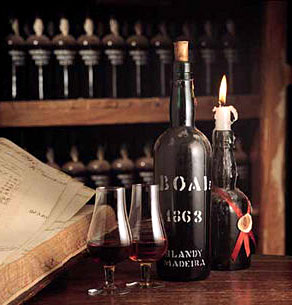 There is a third style of fortified which deserves a mention in that its production process differs slightly from all of the aforementioned fortified wine styles. This is Maderia. The wine is made on the Portuguese island of Madeira from unusual grape varieties like Sercial, Verdelho, Boal, Malvasia, Terrantez, Bastardo and Tinta Negra Mole amongst others. For a full discussion on this wonderful drink, there is a detailed article on this site, "The Madeira Wine Guide" compiled by Dr. Wolf Peter Reutter. For the purposes of this section we bring to the readers attention only the peculiar aspects of Madeira's production. Following pressing and fortification, there are two methods:
There is a third style of fortified which deserves a mention in that its production process differs slightly from all of the aforementioned fortified wine styles. This is Maderia. The wine is made on the Portuguese island of Madeira from unusual grape varieties like Sercial, Verdelho, Boal, Malvasia, Terrantez, Bastardo and Tinta Negra Mole amongst others. For a full discussion on this wonderful drink, there is a detailed article on this site, "The Madeira Wine Guide" compiled by Dr. Wolf Peter Reutter. For the purposes of this section we bring to the readers attention only the peculiar aspects of Madeira's production. Following pressing and fortification, there are two methods:
1. The Estufa process
Young fortified wines which are not considered of the highest quality are transferred to the 'estufa'. In its simplest version, this is a large container, now usually made of stainless steel, with a pipe system in it. The pipes circulate hot water and gradually heat the wine over several days to a temperature between 45- 50 degrees Celsius (120 degrees Fahrenheit). This temperature is maintained for about three months.
Since the heating via the estufa process is rather fast, some of the wine's sugar will turn to caramel. The wine will then display the typical burnt (and sometimes rather bitter) taste of the lower qualities of Madeira wine. When the heating is finished, the wine in the estufa is allowed to cool and after a resting-time (estagio) of 3 months , is then transferred into wooden casks to be stored for years to come. Depending on the intended use, this can be three to fifteen years. There is always some air in the casks and so the wine completely oxidizes. Finally the wine goes into the blend. The cellar master tries to keep the characteristic taste of the shippers wine by blending different wines together. The normal everyday Madeira wine is such a blend, the age given on the label indicating the youngest wine in the blend.
2. The Canteiro process
The very best wines, and all the vintages, are treated according to the 'Canteiro' method. In this process, the casks with the young fortified wine are transferred to the roof of a large room, where they will be deliberately exposed to the sun's heat. (The beam carrying the casks is called a 'canteiro', from which the name of this method derives). The building of Henriques & Henriques in Camara do Lobos, for example, has a huge south facing window in order to collect as much heat as possible. Wines treated with the Canteiro method do not display so much caramel, but rather have a fresh fruity taste. The trade off is that Canteiro wines need much more time to develop than those produced via estufa. As a rule of thumb, 5 years canteiro equal 3 months estufa.
The wines from the canteiro method are also finished in a different way, and can become Vintage Madeiras. This means that they will stay in cask (480 litre Madeira pipes) for a minimum of twenty years, most of them much longer, up to one hundred years or more. During this time the sun's heat leads to further concentration and oxidation. The level of extract, acid, sugar and alcohol rises considerably over the decades (alcohol can reach up to 25% volume in wines with a very long time in cask). However, as in any form of reduction, over-concentration makes the wine undrinkable - so before this occurs, it is transferred to 22 litre glass demi-johns. These demi-johns are then sealed airtight which stops further development of the wine and enables long term storing. Finally the wine is bottled and will then rest another two years before it is put on the market.
Because of its complete oxidation during the maturation process, Madeira wine, like old Tawny Port, is very robust and will keep for years to come, even centuries. - notes on Madeira adapted from The Madeira Wine Guide.

*The official guidelines from the Australia Wine and Brandy Corporation regarding fortification of wines in Australia are as follows:
Grape spirit used to make fortified wine must contain not less than 740 mL/L of ethanol at 20°C. Brandy used to make fortified wine must contain not less than 571 mL/L of ethanol at 20°C. In addition to the substances permitted by clauses 2 and 3 of this Standard, fortified wine may also contain caramel.
1. James Godfrey began his career in the wine industry in 1974 at Wynns Glenoth Winery at Reynella. The following year he commenced the three year Diploma in Oenology at Roseworthy, and over that period worked vintages with Tolley, Saxonvale and Wynns Coonawarra Estate. Of the current Seppelt winemakers, James can lay claim to being the longest serving, having joined the company as Assistant Winemaker in 1978. Seppelt sherries, ports, tokays and muscats are renowned, both in Australia and internationally, as multi-award winners - proof of James' incredible respect and skill with these fine old wines. He maintains the solera systems which produce the Seppelt premium D.P. series of Show Sherries - Fino, Amontillado and Oloroso. Of all the wines in his portfolio, James regards the Seppelt D.P. 90 Show Tawny Port, flagship of the range, as Australia's most acclaimed fortified wine. "It is the benchmark by which all other Australian tawnies are judged."
2. Historical notes on Port partly sourced from www.intowine.com
3. Andrew Sutherland Smith is a fifth generation wine maker to Rutherglen, who's family owned the famous All Saints Winery from 1864 to 1988. Andrew is a graduate and scholar of Charles Sturt University and has worked extensively throughout the Australian wine industry. Since 1981 he has worked for companies including Seppelts, Charles Sturt University (Ron Potter Scholar), Yellowglen, Mildara, Stanley, McWilliams and All Saints. Warrabilla Wines was established in 1991 by Andrew. Whilst developing Warrabilla Wines, Andrew also worked for Chambers Rosewood Winery and Fairfield. Today Andrew's wines reflect his enormous energy and determination to reassert the Sutherland Smith's as a great Australian winemaking force. Australian wine writer James Halliday seems to agree, giving the winery a five star rating being only one of two table wine makers in the North-East to receive the accolade - the other is Giaconda.
(4) Ibid
(5) ibid
(6) Tawny time: Portugal's aged tawny Port is accessible, affordable and ready to drink now. Dave McIntyre, Special to The Chronicle. Thursday, July 6, 2006
(7) ibid
